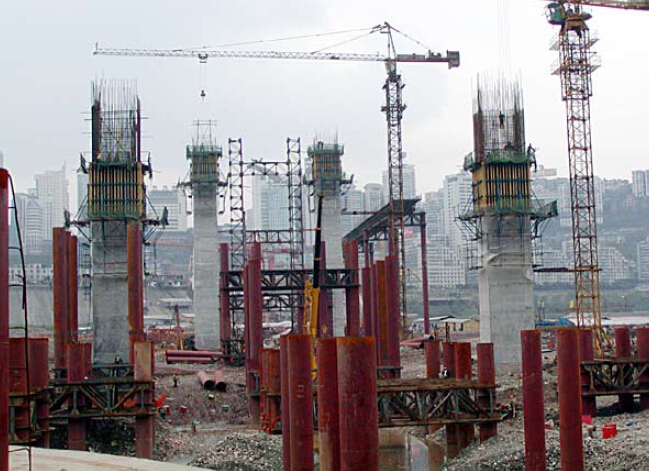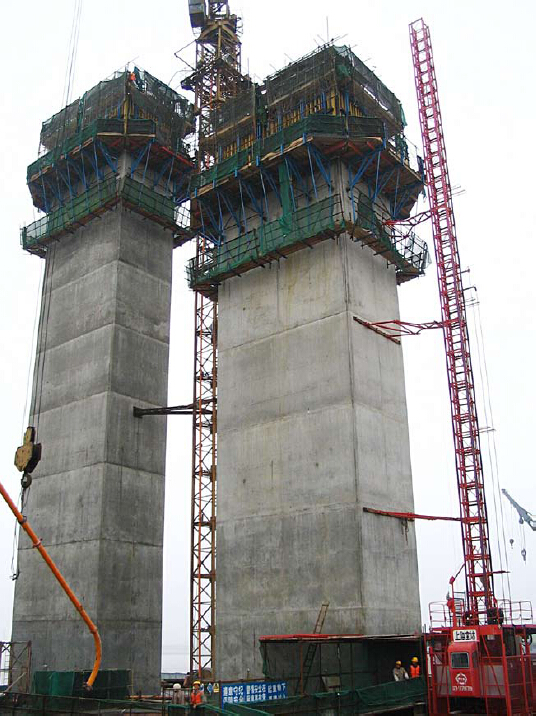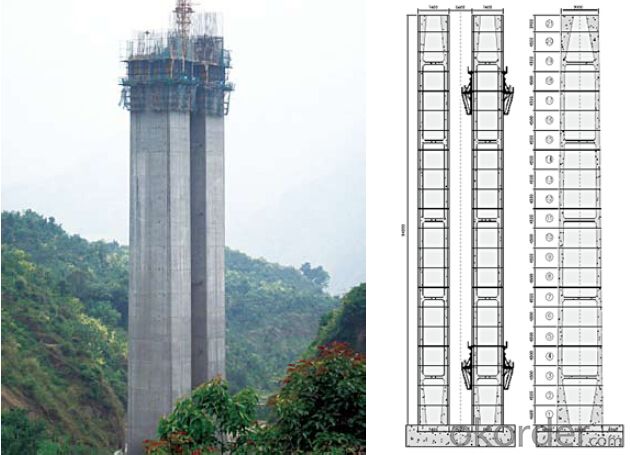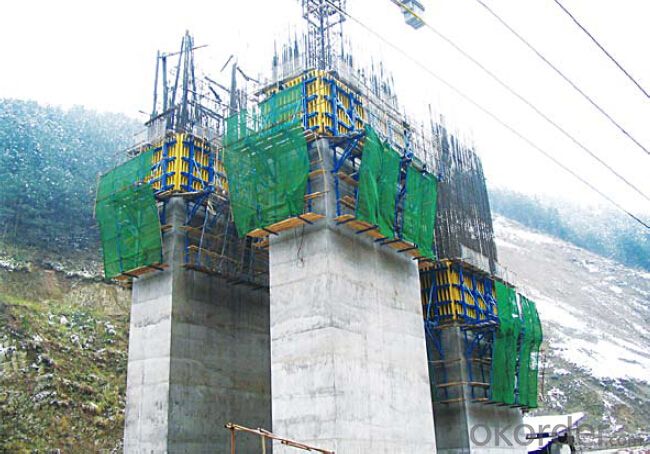Climbing Bracket CB-240 for formwork and scaffolding systems
- Loading Port:
- Tianjin
- Payment Terms:
- TT OR LC
- Min Order Qty:
- 50 m²
- Supply Capability:
- 1000 m²/month
OKorder Service Pledge
OKorder Financial Service
You Might Also Like
Climbing Bracket CB240 & CB210
They are framework brackets for supporting large-area wall formwork.
Typical applications for the CB240&CB210 are pier and column/shear wall/core walll/ in the
building.
CB210 has smaller size than CB240, it will be cost effective in some condition.
Characteristics:
◆ High bearing capacity
The high loading capacity of the brackets allow very large scaffold units. This saves the number
anchor points required as well as reducing climbing times.
◆ Simple moving procedure by crane
Through the strong connection of formwork together with the climbing scaffold, both can be moved
as a single climbing unit by crane. Thus valuable time-savings can be achieved.
◆ Fast striking process without a crane
With the retrusive set, large formwork elements can also be retracted quickly and a minimum of
effort.
◆ Safe with work platform
The platforms have assembled firmly with bracket and will be climbing together, without scaffolding
but can work safely in spite of your high location.


- Q: Can steel formwork be used for underground tunnels?
- Underground tunnels can indeed utilize steel formwork. This material, known for its versatility and durability, is widely employed in various construction endeavors, including underground tunnel projects. Its capacity to withstand the immense pressure and forces from the surrounding soil and rock renders it an ideal choice for tunnel construction. Furthermore, the ease of assembly and disassembly of steel formwork ensures efficient construction and upkeep of tunnels. Given its robustness and resilience, it is no surprise that steel formwork remains a favored option for constructing underground tunnels, guaranteeing a dependable and enduring solution.
- Q: Can steel formwork be used for temporary structures?
- Yes, steel formwork can be used for temporary structures. Steel formwork is durable, strong, and can withstand heavy loads, making it suitable for temporary structures such as scaffolding, shoring, and temporary supports. Its versatility and reusability make it a popular choice in construction projects requiring temporary structures.
- Q: Can steel formwork be used for tall structures?
- Yes, steel formwork can be used for tall structures. Steel is a strong and durable material that can withstand the weight and pressure of concrete. It offers the necessary stability and support required for constructing tall buildings and structures. Additionally, steel formwork is versatile, allowing for flexibility in design and construction.
- Q: How does steel formwork perform in earthquake-prone areas?
- Due to its strength and durability, steel formwork is highly suitable for earthquake-prone areas. The material's resilience allows it to withstand the forces generated during seismic activity, and its excellent tensile strength enables it to resist bending and deformation. In order to ensure stability and safety in earthquake-prone regions, it is crucial to utilize reliable construction methods. Steel formwork provides a robust solution for constructing reinforced concrete structures that can withstand seismic activity. Its stability and rigidity contribute to the structural integrity of concrete elements, even in the face of strong ground shaking. In addition to its reliability, steel formwork offers flexibility in design and construction. It can easily be adjusted or modified to meet architectural and engineering requirements, which is particularly advantageous in areas where seismic resilience is a priority. Another benefit of steel formwork in earthquake-prone areas is its reusability. Being able to dismantle and reuse the formwork multiple times makes it a cost-effective and sustainable choice, which is especially valuable in regions with frequent seismic activity. Furthermore, steel formwork allows for better control over the quality of concrete structures. It helps achieve precise dimensions, shape, and surface finish, all of which are essential for seismic performance. The accuracy and consistency provided by steel formwork contribute to overall structural stability and reduce the risk of failure during earthquakes. Nevertheless, it is important to acknowledge that the effectiveness of steel formwork in earthquake-prone areas also relies on proper engineering design, construction techniques, and adherence to building codes and regulations. Collaborating with experienced professionals, including structural engineers, architects, and construction experts, is vital to ensure the successful utilization of steel formwork in earthquake-resistant construction.
- Q: How does steel formwork handle formwork stripping time?
- Steel formwork is renowned for its durability and strength, characteristics that contribute to its exceptional efficiency in handling formwork stripping time. Unlike traditional wooden formwork, steel formwork has the capacity to endure multiple uses while maintaining its structural integrity. As a result, the stripping time required for steel formwork is significantly reduced when compared to other formwork materials. The rigid construction of steel formwork allows it to bear the weight of concrete and resist deformation during the pouring and curing processes. Consequently, the formwork can be removed more quickly once the concrete has set, as there is less concern about damaging or distorting the formwork. Furthermore, the design of steel formwork incorporates smooth and non-porous surfaces. This characteristic prevents the concrete from bonding with the formwork, facilitating an easier and faster stripping process. Additionally, the smooth surface contributes to a superior finish of the concrete, reducing the need for additional finishing work. Moreover, steel formwork systems often include adjustable features such as adjustable props and modular panels. These features enable easy adjustment and repositioning of the formwork, further enhancing the efficiency of the stripping process. This adaptability allows for faster stripping and reusability of the formwork, resulting in significant time and cost savings. In conclusion, steel formwork excels in managing formwork stripping time due to its durability, strength, and smooth surface. Its ability to withstand multiple uses, resist deformation, and prevent concrete adhesion makes steel formwork highly efficient and time-saving in the construction industry.
- Q: What types of structures can steel formwork be used for?
- Steel formwork can be used for a wide range of structures, including residential buildings, commercial buildings, industrial buildings, bridges, tunnels, dams, and even high-rise buildings. Its versatility and strength make it suitable for various concrete construction projects. Steel formwork systems can be designed and customized to meet the specific requirements of different structures, ensuring precise and accurate concrete pouring. Additionally, steel formwork is durable and can withstand the pressure exerted by the wet concrete, making it ideal for large-scale projects that require long-lasting and reliable formwork systems.
- Q: How does steel formwork affect the overall timeline of a construction project?
- The overall timeline of a construction project can be significantly influenced by the use of steel formwork. One of the main advantages of steel formwork is its durability and reusability. Unlike traditional timber formwork, steel formwork can be utilized multiple times, reducing the time required for constructing and dismantling formwork for each concrete pour. Furthermore, the strength and rigidity of steel formwork enable faster construction cycles. Its ability to withstand higher concrete pressure allows for quicker pouring and setting of concrete, resulting in shorter curing times. This, in turn, permits subsequent construction activities to commence earlier, ultimately accelerating the overall project timeline. Another noteworthy feature of steel formwork is its precision and dimensional stability. It provides a smooth and accurate surface finish, eliminating the need for additional plastering or leveling work. This saves time and reduces the number of construction activities required, thus further enhancing the project timeline. Moreover, steel formwork is typically prefabricated, meaning it is manufactured off-site and delivered ready for assembly at the construction site. This considerably reduces on-site construction time, as the formwork can be swiftly erected and adjusted to the desired shape and dimensions. This timely installation ensures that other trades can progress with their work without delays, ultimately speeding up the overall construction process. However, it is important to acknowledge that the initial setup time for steel formwork may be longer compared to other formwork types, as it necessitates careful planning and coordination. The formwork design must be accurately calculated, and any modifications or adjustments may require additional time. Nevertheless, the time saved during subsequent concrete pours and other construction activities usually compensates for this initial setup period. In conclusion, steel formwork has a positive impact on the overall timeline of a construction project by reducing the time spent on constructing and dismantling formwork, enabling faster concrete pouring and curing, providing a precise and finished surface, and facilitating quick and efficient on-site assembly. Its durability and reusability contribute to a more efficient and timely construction process, resulting in a shorter overall project duration.
- Q: Can steel formwork be used in tunnel construction?
- Certainly, tunnel construction can utilize steel formwork. Steel formwork is extensively employed in various construction endeavors, such as tunnel construction, owing to its resilient nature, formidable strength, and adaptability. It furnishes a sturdy supporting structure capable of withstanding the immense pressure and strain exerted by the encompassing soil and rock during tunneling operations. The design of steel formwork facilitates effortless assembly and disassembly, thereby enabling efficient tunnel construction. It can be tailored to match the specific shape and dimensions of the tunnel, ensuring accuracy and precision in formwork. Furthermore, steel formwork can be repeatedly utilized, rendering it a cost-effective solution for tunnel construction projects.
- Q: Can steel formwork be used for concrete stairs?
- Yes, steel formwork can be used for concrete stairs. Steel formwork is a popular choice for constructing concrete stairs due to its durability and strength. It provides a stable and rigid framework that can withstand the weight and pressure of the concrete during the pouring and curing process. Additionally, steel formwork allows for accurate and precise shaping of the stairs, ensuring a smooth and uniform finish. It is also reusable, making it cost-effective and efficient for multiple construction projects. However, it is important to ensure proper installation and bracing of the steel formwork to ensure the safety and stability of the concrete stairs.
- Q: How is steel formwork adjusted for different concrete thicknesses?
- Steel formwork is adjusted for different concrete thicknesses by using adjustable steel soldiers or props. These steel soldiers are placed vertically at regular intervals along the formwork, providing support and stability. By adjusting the height of these soldiers, the formwork can be raised or lowered to accommodate different concrete thicknesses. To adjust the formwork, the steel soldiers are typically equipped with threaded ends that can be screwed up or down. This allows the formwork to be easily raised or lowered to the desired height. The threaded ends of the soldiers are securely fixed into designated holes or slots on the formwork, ensuring stability and preventing any movement during the pouring and curing of concrete. Additionally, steel formwork systems often include adjustable formwork clamps or brackets. These clamps or brackets are used to secure the formwork panels together, ensuring they remain in the desired position and shape. By adjusting the positions and angles of these clamps or brackets, the formwork can be modified to accommodate variations in concrete thickness. Overall, the adjustable nature of steel formwork, through the use of steel soldiers, props, clamps, and brackets, allows for easy customization and adaptation to different concrete thicknesses. This flexibility ensures that the formwork can effectively contain and shape the concrete during the construction process, resulting in high-quality and structurally sound concrete structures.
Send your message to us
Climbing Bracket CB-240 for formwork and scaffolding systems
- Loading Port:
- Tianjin
- Payment Terms:
- TT OR LC
- Min Order Qty:
- 50 m²
- Supply Capability:
- 1000 m²/month
OKorder Service Pledge
OKorder Financial Service
Similar products
Hot products
Hot Searches



















